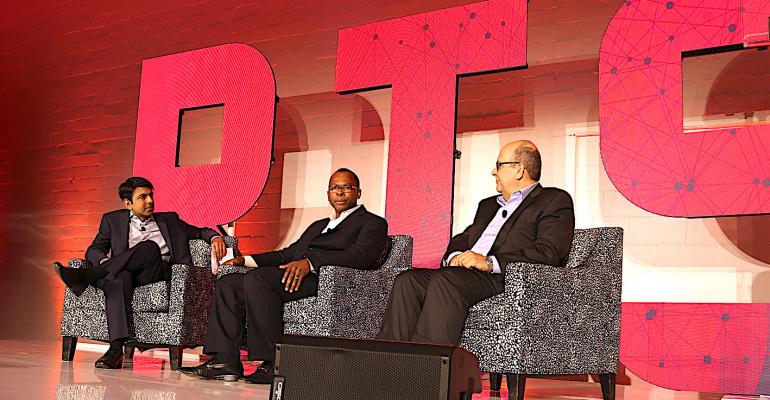Digital executives from Dine Brands Global Inc. and Bloomin’ Brands Inc. see growing demand for information technology in the restaurant industry, and they recently discussed how their roles are changing to accommodate that.
“None of us could have imagined where IT sits today,” said Adrian Butler, chief information officer and senior vice president at Glendale, Calif.-based Dine Brands Global Inc., parent to the IHOP and Applebee’s International Inc., at last month’s National Restaurant Innovation Summit last month in Dallas.
“None of us could have imagined the role that technology plays today in all of our organizations,” Butler said. “There is no earnings call in the world today where technology is not basically No. 1 or 2 in every list.”

Adrian Butler
Butler joined Ramin Eivaz, senior vice president of digital marketing, analytics and customer loyalty at Tampa, Fla.-based Bloomin’ Brands Inc., parent to the Outback Steakhouse and Carrabba’s Italian Grill brands, and panel moderator Upen Sachdev, a principal partner at accounting firm Deloitte, in discussing the changing role of today’s restaurant ITexecutive.
Technology in the restaurant industry in particular has an opportunity to drive the organization and consumer experience, he said.
“There is a thirst in this industry for it,” said Butler, who started his career in Air Force technology.
Eivaz, a computer science undergrad who worked with retail companies like Gallo wines and PepsiCo, said he got into technology to help understand the consumer better.
“As I looked at all the key business priorities we had — off-premise, delivery, online sales, personalization, loyalty, and I can go down the list — the one thing that connected all the dots went back to the customer strategy,” Eivaz said. “What is it you are trying to do to sell more?”
The information officer’s job is to drive incremental sales and traffic and, as a result, to improve profitability,” Eivaz said.
“To do that,” he said, “you have to understand your consumers.”
Part of the technology officer’s job is to help restaurant companies move from a mass approach with one solution toward a one-to-one relationship — “where one day I recognize you, have a relevant conversation, direct content and specific promotions only for you,” Eivaz added.
That comes with leveraging data and technology to get closer to that one-to-one approach, he said. “Ultimately, we’re here to provide a true omnichannel experience.”
“Digital is what it means to you and your organization,” Butler of Dine Brands added. “Ultimately, at the end of the day, you understand your guest and you understand their demands. You understand the market in which you are operating.”
“When guests come to see you today, they are all in a hurry,” Butler said, offering that as a reason delivery is booming. “What is the digital experience going to look like to reinforce that?”
For franchise restaurant organizations, Butler said, part of the digital executives’ job includes turning technical language into a discussion of business capability, be it digital, e-commerce or mobile ordering and payment.
Dine Brands has a total of about 450 franchisees around the world, and Butler said part of his job is convincing them that technological investments make good business sense.
“For us, it’s engaging our franchise community early, educating them and ensuring that they are aware of all things that are going on in the marketplace,” Butler said. “There’s a lot of benchmarking with others that are in our competitive set. We’re really equipping them ways to think about it.”
Being a predominantly asset-light franchise organization requires the digital team to take an extra step with the franchise community.
“We pull them in really, really early,” he said. “We engage them in the ideation aspects of what people are seeing.”
Eivaz said that digital strategies have been proven in the retail space and consumer expectations have grown as to what technological offerings are available.
“The consumer has been exposed to the experiences of Uber and Amazon and other places,” he said. “That surprises and delights them. They come to expect that from everywhere.”
Eivaz said technology executives still have present a business case to justify digital investments, balancing their roadmaps.
“On a quarterly basis,” he said, “I’m delivering some benefits, while on parallel, I’m investing and building on the longer-term infrastructure elements.”
The new digital environment requires information technology teams to be agile, Eivaz added. If something isn’t working, the team must be willing to cut it quickly.
“Clearly more customers are looking for us to be more one-to-one with them,” Eivaz said. “We get substantial lift when we are able to connect with customers on a one-to-one basis.” Messaging for members of the loyalty programs could differ from those who are infrequent users, he said.
Customers listen to messages that are focused on them individually,” he said, rather than those that are broad-based and bombard them every day.
Contact Ron Ruggless at [email protected]
Follow him on Twitter: @RonRuggless





